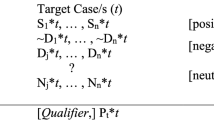Abstract
A number of different approaches to model analogies and analogical reasoning in AI have been proposed, applying different knowledge representation and mapping strategies. Nevertheless, analogies still seem to be hard to grasp from a formal perspective, with no known treatment in the literature of, in particular, their formal semantics, though the empirical treatments involving human subjects are abundant. In this paper we present a framework that allows to analyze the syntax and the semantics of analogies in a universal logic-based setting without committing ourselves to a specific type of logic. We show that the syntactic process of analogy-making by finding a generalization can be given a sensible interpretation on the semantic level based on the theory of institutions. We then apply these ideas by considering a framework of analogy-making that is based on classical first-order logic.

Similar content being viewed by others
Notes
In [9], an uncommon, third mode is presented, for which a computational model is difficult to implement.
The reader can refer to [14] for a more exhaustive elaboration on this particular topic of coverage.
This concept is based on [16, section 5.3].
The use of ‘implantation’ here is closest in meaning to the notion of ‘embedding’ (in the sense of seeding).
Remember that, as stated in Sect. 2.1, we refer by an arbitrary logical framework to a general KRR framework that represents knowledge using a logic-based language.
To improve readability we omit the sortal specifications of terms in this paper.
Restricted higher-order anti-unification resembles to a certain extent strategies proposed in the context of ontology repair plans [17].
In fact, the basic substitutions are special cases of second-order substitutions in first-order logic, which can also be described as derived signature morphisms, cf. [16, 101].
References
Schwering A, Kühnberger K-U, Kokinov B (2009) Analogies: integrating multiple cognitive abilities (guest editorial). Special Issue Anal Integr Cogni Abil J Cognit Syst Res 10(3):175–177
Bartha P (2013) Analogy and analogical reasoning. In: Zalta EN (ed) The Stanford encyclopedia of philosophy, fall 2013 edn. The Metaphysics Research Lab, Stanford University, Stanford
Kokinov B, Holyoak K, Gentner D (eds) (2009) New frontiers in analogy research. NBU Press, Sofia
Hofstadter D, the Fluid Analogies Research Group (1995) Fluid concepts and creative analogies. Computer models of the fundamental mechanisms of thought. Basic Books, New York
Falkenhainer B, Forbus K, Gentner D (1989) The structure-mapping engine: algorithm and example. Artif Intell 41:1–63
Dastani M, Indurkhya B, Scha R (2003) Analogical projection in pattern perception. J Exp Theor Artif Intell 15(4):489–511. https://doi.org/10.1080/09528130310001626283
Hummel JE, Holyoak KJ (1996) Lisa: a computational model of analogical inference and schema induction. In: Cottrell GW (ed) Proc. of the 18th annual conference of the cognitive science society, pp 52–357
Kokinov BN, Petrov AA (2001) Integration of memory and reasoning in analogy-making: the AMBR model. In: Gentner D et al (eds) The analogical mind: perspectives from cognitive science. MIT Press, Cambridge, pp 59–124
Indurkhya B (1992) Metaphor and cognition: an interactionist approach. Studies in cognitive systems. Kluwer Academic, Dordrecht
Goertzel B, Pennachin C (2010) Artificial general intelligence. Cognitive technologies. Springer, Berlin
Goguen J, Roşu G (2002) Institution morphisms. Form Asp Comput 13(3–5):274–307
Gentner D, Holyoak K, Kokinov B (eds) (2001) The analogical mind: perspectives from cognitive science. MIT Press, Cambridge
Clement JJ (2008) Creative model construction in scientists and students: the role of imagery, analogy, and mental stimulation. Springer, London
Abdel-Fattah A, Besold T, Kühnberger K.-U (2012) Creativity, cognitive mechanisms, and logic. In: Bach J, Goertzel B, Iklé M (eds) Proc. of the 5th conference on AGI, Oxford, vol 7716 of lecture notes in computer science, pp 1–10
Goguen JA, Burstall RM (1992) Institutions: abstract model theory for specification and programming. J ACM 39:95–146
Diaconescu R (2008) Institution-independent model theory. Studies in universal logic. Birkhäuser, Basel
McNeill F, Bundy A (2007) Dynamic, automatic, first-order ontology repair by diagnosis of failed plan execution. Int J Semant Web Inf Syst 3:1–35
Fodor JA (1983) The modularity of mind. A Bradford book. MIT Press, Cambridge
Bermúdez J (2014) Cognitive science: an introduction to the science of the mind. Cambridge University Press, Cambridge
Chan M, Lehmann J, Bundy A (2010) Higher-order representation and reasoning for automated ontology evolution. In: Proceedings of the international conference on knowledge engineering and ontology development, pp 84–93
Author information
Authors and Affiliations
Corresponding author
Rights and permissions
About this article
Cite this article
Abdelfattah, A.M.H., Krumnack, U. Semantics of Analogies from a Logical Perspective. Künstl Intell 33, 243–251 (2019). https://doi.org/10.1007/s13218-019-00598-x
Received:
Accepted:
Published:
Issue Date:
DOI: https://doi.org/10.1007/s13218-019-00598-x




